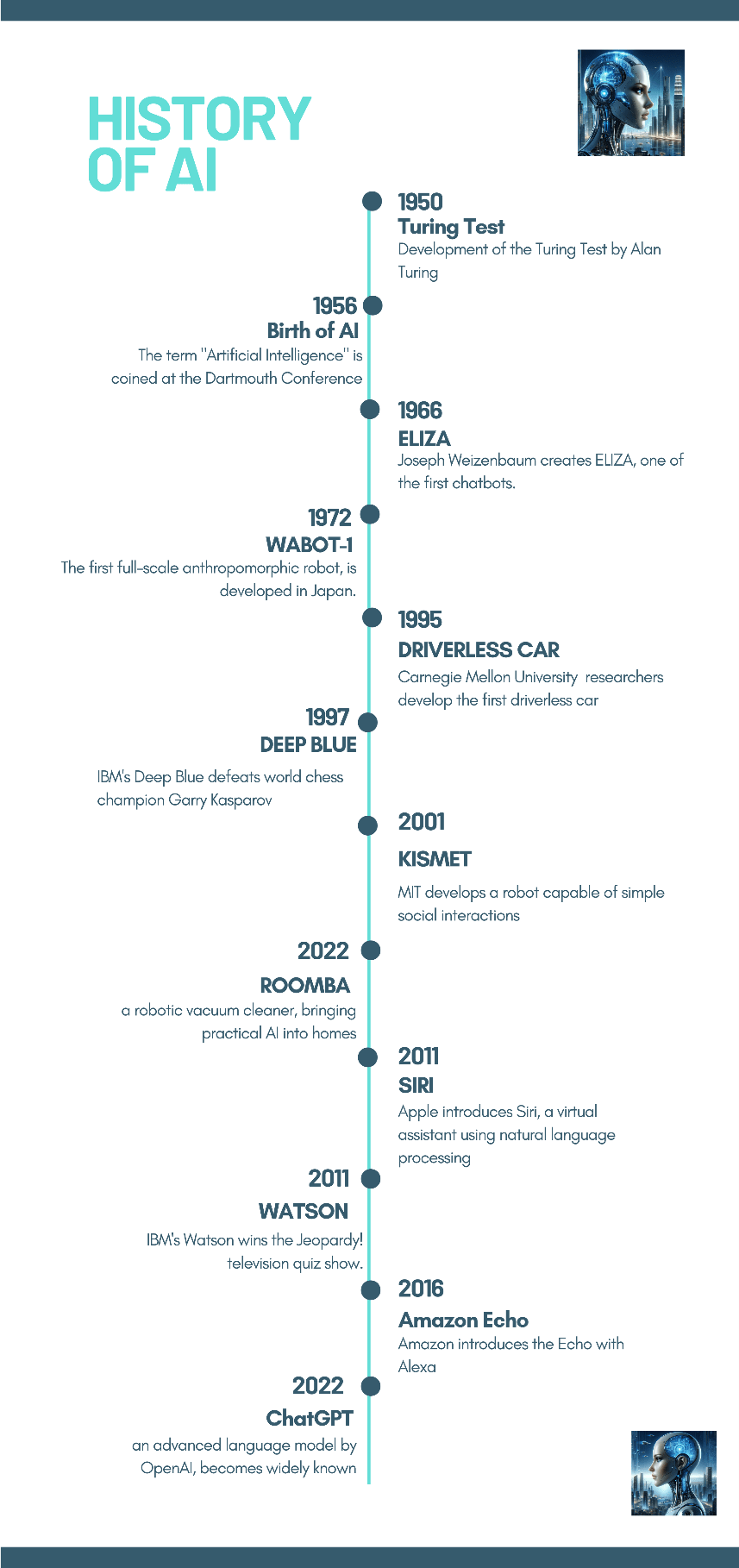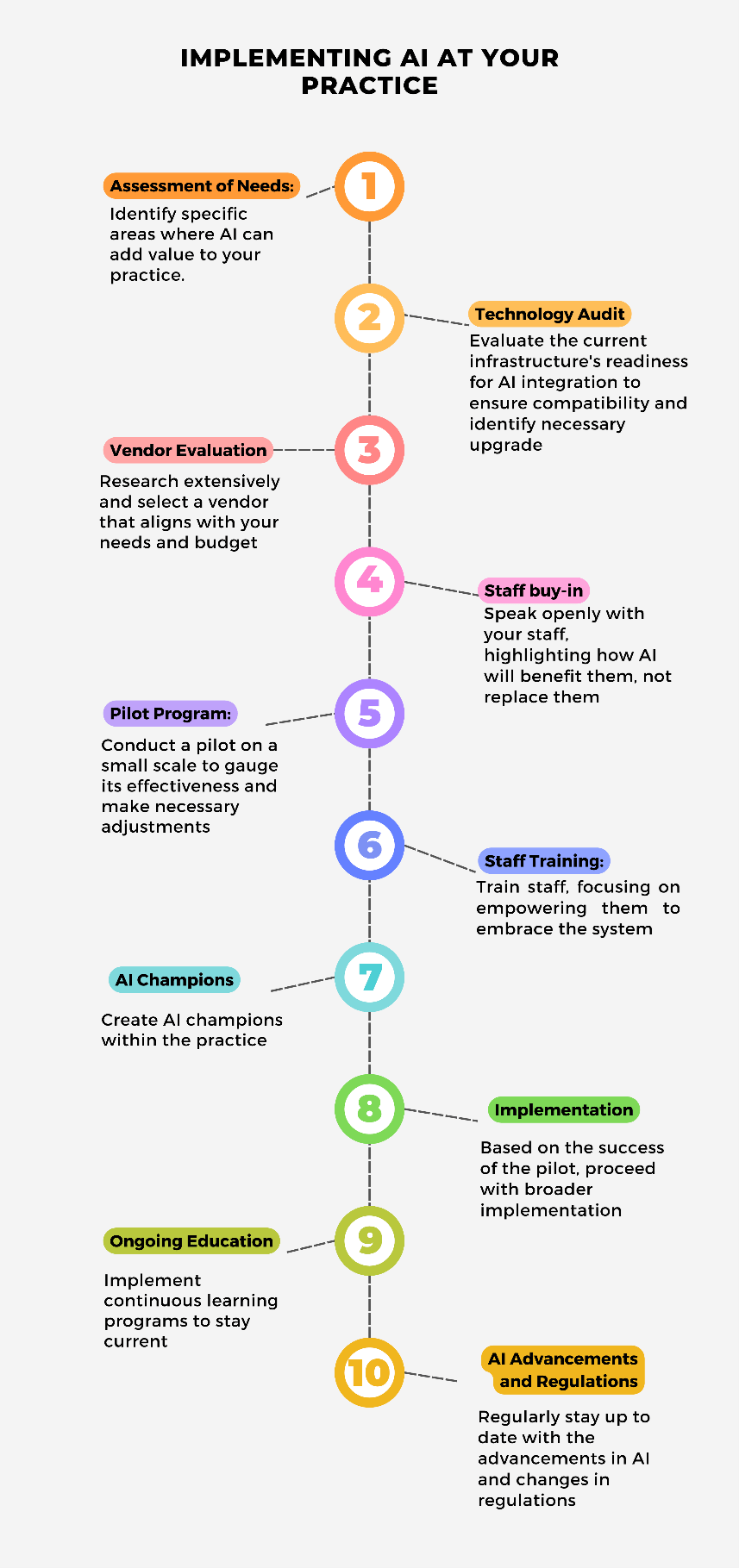Set your practice up for success with our eBook. Discover how to improve patient experience and boost revenue.
Download eBookNon-Clinical Applications of AI in the Dental Industry
What is Artificial Intelligence?
For years, the concept of Artificial Intelligence (AI) has fascinated and captured our imagination. The average person often viewed AI as a futuristic concept, and this view was supported by its portrayal in popular culture, ranging from the crafty and calculating HAL 9000 in the 1968 movie “2001: A Space Odyssey”, to the know-it-all Data in Star Trek and the indestructible Terminator. However, it is no longer a futuristic theory but something woven into the fabric of our everyday life.
The history of AI can be traced back to 1950 when Alan Turing introduced the Theory of Computation. Since then, we have seen advents such as driverless cars and smart assistants. However, it wasn’t until the introduction of ChatGPT that the average punter got to experience first-hand the power of AI.
Although we may not realise it, today, AI is everywhere we look. The smart assistant on your smartphone, smart cars that read speed signs, tailored social media feeds and even online searches that predict what you are looking for are all powered by AI. For context, the average smartphone user unlocks their phone 79 times a day with facial recognition while the streaming juggernaut Netflix makes recommendations to over 247 million users worldwide.
So what is Artificial Intelligence? Although there are many definitions around, one of the simplest ones comes from IBM; “Artificial Intelligence leverages computers and machines to mimic the problem-solving and decision-making capabilities of the human mind.” Not only do the machines today mimic human capabilities, but also at a much faster rate with much more data and incredible accuracy.

Non-clinical applications of AI
Despite its widespread use in other fields, the non-clinical application in the dental industry remains under-explored due to much of the attention, rightly so, has been paid to its clinical counterparts. From a clinical perspective, AI has already revolutionised dentistry with image analysis, diagnostics, treatment planning, detections and predictions. Nevertheless, there are some encouraging signs with some fascinating trends emerging in the non-clinical arena of the dental industry. Let’s explore some of these trends.
Appointment Scheduling
One of the uses of AI that is seeping into the dental arena is smart rostering, where the algorithms can analyse appointments, historical revenue, patient trends, clinician trends and seasonal trends and make recommendations on the best use of their time. This can vary from recommendations on what days/times to open, what type of appointments to book and even when the clinician should book time off.
Regarding patient appointments, AI models can analyse various factors such as patients’ past behaviours, preferences, clinician availability and treatment durations and make recommendations that consider the patient’s convenience and the practice’s revenue targets. It gets even better when a patient reschedules an appointment. The rescheduling can happen in ways that have the minimum impact on the practice revenue.
Cancellations and no-shows can be minimised with the assistance of AI, where the models can predict with a great deal of accuracy the probability of a particular patient cancelling or failing to attend their appointment. Moreover, when a last-minute cancellation occurs, the system can automatically find the most suitable patient to fill that gap by considering a vast amount of data that includes patient preferences, treatment type, location and other factors.
Inventory Management
One of the biggest challenges dental practices face regarding inventory management is over and under-ordering. This is as common as poor inventory tracking. AI-driven inventory management systems can analyse historical usage data, seasonal trends and other factors, predict supply needs, and place precise orders on your behalf. A natural result of precision ordering is the elimination of expired supplies and optimised practice budgets because you will be ordering just the right supplies.
Another exciting aspect of AI is real-time inventory tracking using the Internet of Things, such as actuators. This, in its own right, is going to revolutionise inventory management.
Voice-based Assistants
With voice-based assistants that use conversational AI, practices can provide their patients access to speak to someone 24/7, not only to make appointments but to answer questions and provide information. With the right training in practice operations, these assistants can triage patients and offer suitable appointments just the same way a human receptionist would. I was once fortunate enough to witness a demonstration of such a system called “Olivia” that could make an appointment and provide information to a fictional patient with a complex array of needs. To say that experience blew me away is an understatement.
If you ask a dental receptionist what the most tedious task of their day is, 9 times out of 10, you would hear the post-treatment follow-up calls. Voice-based assistants can relieve receptionists of this task and make those phone calls, often multiple at once, and only notify the humans where a patient needs attention. Most fascinatingly, they can analyse call notes to detect patient’s tone and mood and provide real-time insights to better understand the effectiveness of each call.
Patient Engagement
AI models can send appointment and recall reminders tailored to individual patients. They can analyse each patient and tailor elements such as the language and tone of the message, medium used, frequency and even the time of the day to ensure the best response rates.
Furthermore, AI can help practices to ensure that the practice is front of mind for the patient by sending personalised oral health and patient education tips based on the patient’s oral health condition, treatment requirements and interests. A common characteristic of successful practices is their engagement with patients between visits. It no longer has to be six months between your interactions with your patients. The system can remember significant events in the patient’s life and send messages on the practice’s behalf. Imagine the patient Mary’s surprise when she gets a congratulatory message from her dentist and the team on her wedding day.
Thanks to some brilliant researchers at Columbia University’s Center for Precision Dental Medicine, the technology powered by AI is available to detect the patient’s stress levels by monitoring their heart rate and blood oxygen levels. This technology can be helpful when dealing with patients with severe anxiety about visiting the dentist.
Data Analytics
The power of Business Intelligence can be enhanced tenfold by integrating it with Artificial Intelligence. Some integrated applications come in the form of smart assistants. Imagine being able to say, “Hey Siri (or Alexa), what is my hourly production for this month?” or “How many implant cases do I need to perform to stay on target this month?”. The mystery of data analytics will be unravelled right in front of your eyes without ever having to look at another report, chart or dashboard.
Furthermore, AI models can analyse revenue and patient retention patterns and make recommendations on optimising your practice’s performance. This can come in the form of predicting the patients at high risk of leaving the practice or analysing patient cohorts based on a broader range of characteristics than their age, gender and spending.
Today, the technology is available for practice owners to have their AI systems monitor the practice performance metrics and create alerts when significant events occur. Imagine driving along the highway, only for your smart assistant to say, “Congratulations, Dr Smith, your Sydney practice has just achieved its monthly revenue target”? The once-futuristic concepts are here.
What does the future hold for AI?
According to Statista, the global AI market is projected to experience significant growth in the next 7 years with a compound annual growth rate (CAGR) of 17.3%, resulting in market size of 1125.89 billion AUD by 2030, while Bloomberg Intelligence predicts that the Generative AI market (the all familiar ChatGPT and friends) will grow at a CAGR of 42% over the next nine years ballooning to a market size of 1.83 trillion AUD by 2023. Not to be outdone, the global Dental AI market is expected to grow to a staggering 54.86 billion AUD by 2026. It is safe to say that the AI revolution has already started.
Ethical Considerations
Implementing AI at a dental practice is not merely a technological upgrade. It comes with its own set of ethical considerations. As AI begins to play a crucial role in enhancing patient experience and operational efficiency, dental practices must navigate the ethical landscape with diligence.
In the healthcare sector, the privacy of patient data is paramount. This involves protecting the personal and sensitive information from unauthorised access or breaches. Given that AI systems often require large datasets with patient information, the measures taken to protect that data are of great importance. The protection of patient data can be enhanced with activities such as compliance with the Privacy Act 1988, which includes the Australian Privacy Principles (APPs), robust cybersecurity measures and anonymising patient data where possible.
Today’s AI systems are well known for their biases depending on the datasets used to train the models. It is of vital importance that practices are not only aware of these biases but also take the necessary steps to address those biases.
Implementing clear and transparent consent processes is vital. Patients should be informed about what data is collected, how it is used, and the role of AI in their dealings with the practice. The patient must be given assurances about the security and privacy of their data. Furthermore, it is important to build a culture of trust around AI use is essential. Patients should feel comfortable asking questions and confident in receiving clear, understandable answers.
A Strategic Framework for AI Integration at your dental practice
A strategic, step-by-step approach is essential for dental practices looking to integrate AI. This 10-step framework will help you get started.

Conclusion
AI is rapidly revolutionising all aspects of society, and dentistry is no exception. From optimising operational efficiency to enhancing patient experiences, AI has immense transformative potential in dental practices. Leveraging the latest advancements in machine learning and natural language processing, AI systems can streamline everything from appointment scheduling to inventory management to patient communications.
However, to realise the full promise of AI, dental practices must navigate critical challenges around data privacy, algorithmic bias, system transparency, and building patient trust. Dental teams can proactively address these concerns by implementing ethical frameworks around consent, security, and oversight.
With a strategic, step-by-step approach grounded in patient care values and technological possibilities, dental practices are poised to lead healthcare into a new AI-enabled era. From predictive analytics to voice-based assistants, deploying AI with wisdom and foresight will allow dentistry to deliver patients more personalised, preventative and precise care.
Though AI comes with risks, practices that skillfully integrate it while prioritising understanding, transparency, and compassion will improve dentistry. By augmenting human strengths rather than replacing them, AI can elevate the human elements at the heart of dental care – trust, empathy and dignity. With diligent stewardship, this revolutionary technology may not only change dentistry but change it for the good of all.
About the Author
Sean has 18 years of experience in the Australian Dental Information System industry and currently works as Head of Product and Innovation at Centaur Software. Sean holds a Bachelor of Applied Science from RMIT University and a Master of Business Administration from Swinburne University.
Sean is a passionate data analyst who loves everything data. Outside work, Sean spends most of his time doting on his little daughters, Amelia and Olivia.
Related Posts
-
Dental clinic marketing: Promote your practice
Published: 11/7/2024As the operator of a dental practice, you're aware of...
-
Best practices for dental practice management
Published: 4/7/2024As a dental practice owner, you want to keep your...
-
5 Tips to Grow Your Dental Practice
Published: 27/6/2024As a dentist or dental professional in Australia, you know...

